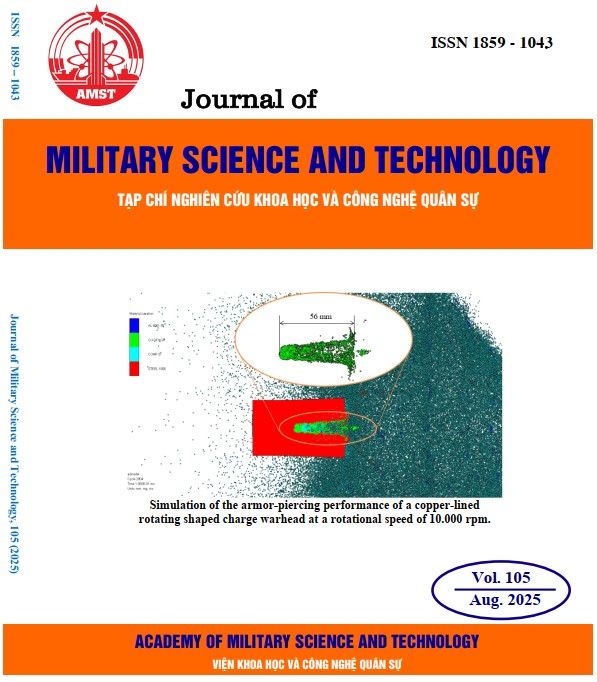Application of the SQP algorithm in leader–follower formation control
398 viewsDOI:
https://doi.org/10.54939/1859-1043.j.mst.105.2025.11-19Keywords:
SQP; DMPC; Leader-Follower; Omnidirectional robots.Abstract
This paper proposes the application of the Sequential Quadratic Programming (SQP) algorithm to control a group of omnidirectional mobile robots using the Leader-Follower model. The method includes predicting the group’s kinematics, formulating a distributed model predictive control (DMPC) problem with a cost function comprising components for formation maintenance, trajectory tracking, and collision avoidance. The cost function is then optimized in real time using the SQP algorithm. In simulations, Gaussian noise is introduced into the states and control signals to evaluate the method’s effectiveness under real-world deployment conditions.
References
[1]. Nocedal, J., & Wright, S, “Numerical Optimization” (2nd ed.), Springer, (2006).
[2]. Zheng, Y., Wang, L., & Yang, G. "Distributed optimal coordination for multi-agent systems with leader–follower structure via a novel SQP method”, Journal: IEEE Transactions on Cybernetics, (2018)
[3]. Wang, Xinghu, Dabo Xu, and Yiguang Hong. "Consensus control of nonlinear leader–follower multi-agent systems with actuating disturbances." Systems & Control Letters 73, (2014). DOI: https://doi.org/10.1016/j.sysconle.2014.09.004
[4]. Javier Alonso-Mora, Stuart Baker and Daniela Rus. “Multi-robot navigation in formation via sequential convex programming”, IEEE/RSJ International Conference on Intelligent Robots and Systems, (2015). DOI: https://doi.org/10.1109/IROS.2015.7354037
[5]. Andrea Carron, Danilo Saccani, Lorenzo Fagiano, Melanie N. Zelinger, “Multi-agent Distributed Model Predictive Control with Connectivity Constraint”, IFAC-PapersOnline 56-2, (2023). DOI: https://doi.org/10.1016/j.ifacol.2023.10.1310
[6]. E.F. Camacho, C.Bordons, “Model Predictive Control “ (2nd ed). Springer, (2006). DOI: https://doi.org/10.1007/978-0-85729-398-5
[7]. Boyd, S., Parikh, N., Chu, E., Peleato, B., & Eckstein, J, “Distributed Optimization and Statistical Learning via the Alternating Direction Method of Multipliers”, Foundations and Trends in Machine Learning, (2011). DOI: https://doi.org/10.1561/2200000016
[8]. Mayne, D. Q., Seron, M. M., & Raković, S. V, “Robust model predictive control of constrained linear systems with bounded disturbances”, Automatica, (2005). DOI: https://doi.org/10.1016/j.automatica.2004.08.019
[9]. J. M. Maestre, R. Negenborn, “ Distributed Model Predictive Control Made Easy”, Springer, (2014). DOI: https://doi.org/10.1007/978-94-007-7006-5
[10]. Tran Thi Minh Dung, “Nghiên cứu về thuật toán đồng thuận Cho hệ thống đa đối tượng”. Journal of Science and Technology – The University of Danang, Vol. 6, No. 103, (2016) (in Vietnamese).
[11]. Trinh Hoang Minh, Nguyen Minh Hieu, “Điều khiển hệ đa tác tử”, Hanoi University of Science and Technology, (2021) (in Vietnamese).
[12]. Nguyen Thi Tuyet Hoa, Nguyen Tuan Minh, “Điều khiển nhóm phân tán cho hệ đa tác tử dựa trên lý thuyết đồ thị cứng ứng dụng trong theo dõi mục tiêu di động”, TNU journal of science and technology, (2023) (in Vietnamese).
[13]. H. Do, H. Nguyen, C. Nguyen, M. Nguyen, and M. Nguyen, “Formation control of multiple unmanned vehicles based on graph theory: A comprehensive review”, EAI Endorsed Transactions on Mobile Communications and Applications, (2022).







